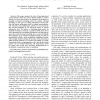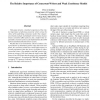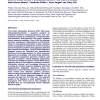84 search results - page 13 / 17 » Anonymizing sequential releases |
ACSC
2008
IEEE
13 years 11 months ago
2008
IEEE
A number of organizations publish microdata for purposes such as public health and demographic research. Although attributes of microdata that clearly identify individuals, such a...
CSFW
2011
IEEE
12 years 9 months ago
2011
IEEE
—This paper explores the idea of knowledge-based security policies, which are used to decide whether to answer queries over secret data based on an estimation of the querier’s ...
ICDCS
1996
IEEE
14 years 1 months ago
1996
IEEE
This paper presents a detailed comparison of the relative importance of allowing concurrent writers versus the choice of the underlying consistency model. Our comparison is based ...
CIKM
2009
Springer
14 years 4 months ago
2009
Springer
Data generalization is widely used to protect identities and prevent inference of sensitive information during the public release of microdata. The k-anonymity model has been exte...
NAR
1998
13 years 9 months ago
1998
The Protein Information Resource (PIR; http://wwwnbrf.georgetown.edu/pir/ ) supports research on molecular evolution, functional genomics, and computational biology by maintaining...



